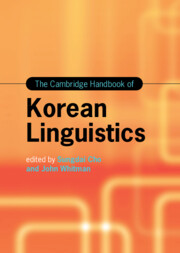Book contents
- The Cambridge Handbook of Korean Linguistics
- Cambridge Handbooks in Language and Linguistics
- The Cambridge Handbook of Korean Linguistics
- Copyright page
- Contents
- Figures
- Tables
- Contributors
- Preface
- Acknowledgments
- Abbreviations
- Part I Korean Overview
- Part II Phonetics and Phonology
- Chapter 7 Vowel Harmony
- Chapter 8 The Phonology and Phonetics of Korean Stop Laryngeal Contrasts
- Chapter 9 The Phonetics-Prosody Interface and Prosodic Strengthening in Korean
- Chapter 10 Constituent Structure and Sentence Phonology of Korean
- Chapter 11 Effects of Linguistic Experience on the Perception of Korean Stops
- Part III Morphology and Syntax
- Part IV Semantics and Pragmatics
- Part V Sociolinguistics and Psycholinguistics
- Part VI Language Pedagogy
- Index
- References
Chapter 7 - Vowel Harmony
from Part II - Phonetics and Phonology
Published online by Cambridge University Press: 30 September 2022
- The Cambridge Handbook of Korean Linguistics
- Cambridge Handbooks in Language and Linguistics
- The Cambridge Handbook of Korean Linguistics
- Copyright page
- Contents
- Figures
- Tables
- Contributors
- Preface
- Acknowledgments
- Abbreviations
- Part I Korean Overview
- Part II Phonetics and Phonology
- Chapter 7 Vowel Harmony
- Chapter 8 The Phonology and Phonetics of Korean Stop Laryngeal Contrasts
- Chapter 9 The Phonetics-Prosody Interface and Prosodic Strengthening in Korean
- Chapter 10 Constituent Structure and Sentence Phonology of Korean
- Chapter 11 Effects of Linguistic Experience on the Perception of Korean Stops
- Part III Morphology and Syntax
- Part IV Semantics and Pragmatics
- Part V Sociolinguistics and Psycholinguistics
- Part VI Language Pedagogy
- Index
- References
Summary
Chapter 7 deals with a longstanding controversy from both historical and theoretical linguistic perspectives. The chapter provides a description of Korean vowel harmony beginning with an overview of its historical and theoretical linguistic background. Middle Korean displays relatively rigorous patterns of vowel harmony; contemporary varieties show reduced but still complicated patterns that are confined to certain morphological contexts, as a result of historical changes. The description of Korean vowel harmony in this chapter is divided mainly into two parts: the relatively complete vowel harmony system in Middle Korean, and vowel harmony in contemporary (chiefly Seoul) Korean. The former provides an historical and typological overview of the productive MK patterns, while the latter focuses on the exceptions and variations of the remnant harmony patterns in ideophones and verbal inflections. The remainder of the chapter introduces a number of theoretical approaches, from early generative treatments to more recent Optimality Theoretic analyses.
Keywords
- Type
- Chapter
- Information
- The Cambridge Handbook of Korean Linguistics , pp. 177 - 214Publisher: Cambridge University PressPrint publication year: 2022
References
- 1
- Cited by

